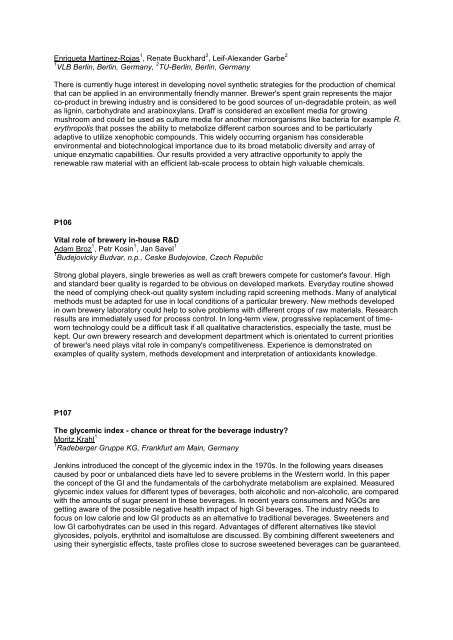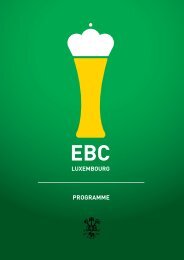here - the 34th European Brewery Convention
here - the 34th European Brewery Convention
here - the 34th European Brewery Convention
You also want an ePaper? Increase the reach of your titles
YUMPU automatically turns print PDFs into web optimized ePapers that Google loves.
Enriqueta Martinez-Rojas 1 , Renate Buckhard 2 , Leif-Alexander Garbe 2<br />
1 VLB Berlin, Berlin, Germany, 2 TU-Berlin, Berlin, Germany<br />
T<strong>here</strong> is currently huge interest in developing novel syn<strong>the</strong>tic strategies for <strong>the</strong> production of chemical<br />
that can be applied in an environmentally friendly manner. Brewer's spent grain represents <strong>the</strong> major<br />
co-product in brewing industry and is considered to be good sources of un-degradable protein, as well<br />
as lignin, carbohydrate and arabinoxylans. Draff is considered an excellent media for growing<br />
mushroom and could be used as culture media for ano<strong>the</strong>r microorganisms like bacteria for example R.<br />
erythropolis that posses <strong>the</strong> ability to metabolize different carbon sources and to be particularly<br />
adaptive to utilize xenophobic compounds. This widely occurring organism has considerable<br />
environmental and biotechnological importance due to its broad metabolic diversity and array of<br />
unique enzymatic capabilities. Our results provided a very attractive opportunity to apply <strong>the</strong><br />
renewable raw material with an efficient lab-scale process to obtain high valuable chemicals.<br />
P106<br />
Vital role of brewery in-house R&D<br />
Adam Broz 1 , Petr Kosin 1 , Jan Savel 1<br />
1 Budejovicky Budvar, n.p., Ceske Budejovice, Czech Republic<br />
Strong global players, single breweries as well as craft brewers compete for customer's favour. High<br />
and standard beer quality is regarded to be obvious on developed markets. Everyday routine showed<br />
<strong>the</strong> need of complying check-out quality system including rapid screening methods. Many of analytical<br />
methods must be adapted for use in local conditions of a particular brewery. New methods developed<br />
in own brewery laboratory could help to solve problems with different crops of raw materials. Research<br />
results are immediately used for process control. In long-term view, progressive replacement of timeworn<br />
technology could be a difficult task if all qualitative characteristics, especially <strong>the</strong> taste, must be<br />
kept. Our own brewery research and development department which is orientated to current priorities<br />
of brewer's need plays vital role in company's competitiveness. Experience is demonstrated on<br />
examples of quality system, methods development and interpretation of antioxidants knowledge.<br />
P107<br />
The glycemic index - chance or threat for <strong>the</strong> beverage industry<br />
Moritz Krahl 1<br />
1 Radeberger Gruppe KG, Frankfurt am Main, Germany<br />
Jenkins introduced <strong>the</strong> concept of <strong>the</strong> glycemic index in <strong>the</strong> 1970s. In <strong>the</strong> following years diseases<br />
caused by poor or unbalanced diets have led to severe problems in <strong>the</strong> Western world. In this paper<br />
<strong>the</strong> concept of <strong>the</strong> GI and <strong>the</strong> fundamentals of <strong>the</strong> carbohydrate metabolism are explained. Measured<br />
glycemic index values for different types of beverages, both alcoholic and non-alcoholic, are compared<br />
with <strong>the</strong> amounts of sugar present in <strong>the</strong>se beverages. In recent years consumers and NGOs are<br />
getting aware of <strong>the</strong> possible negative health impact of high GI beverages. The industry needs to<br />
focus on low calorie and low GI products as an alternative to traditional beverages. Sweeteners and<br />
low GI carbohydrates can be used in this regard. Advantages of different alternatives like steviol<br />
glycosides, polyols, erythritol and isomaltulose are discussed. By combining different sweeteners and<br />
using <strong>the</strong>ir synergistic effects, taste profiles close to sucrose sweetened beverages can be guaranteed.





